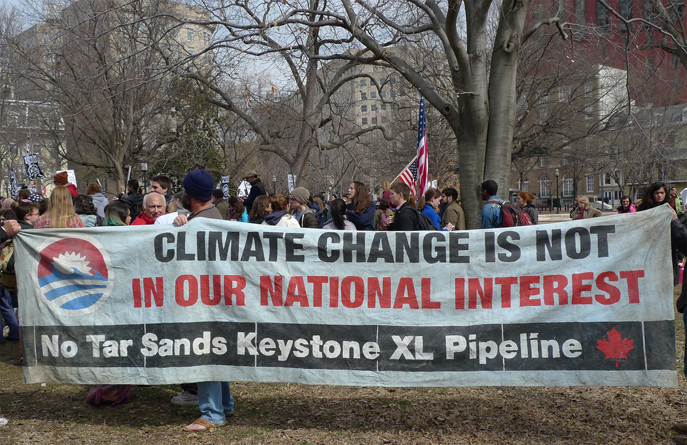"The Keystone XL Pipeline would not serve the national interest of the United States." These are the words we waited seven long years to hear and the very same words proclaimed by President Obama in his long-awaited announcement last November. These are also the words that TransCanada -- the company behind Keystone XL -- refuses to accept.
On January 6, TransCanada revealed that it is fighting the denial of Keystone XL with two legal actions:
1) A lawsuit against the Obama Administration for exceeding the executive powers conferred by the Constitution, which will take place before the U.S. Federal District Court in Houston, TX; and
2) A claim under the North American Free Trade Agreement (NAFTA) to collect $15 billion in damages from the U.S. (i.e., from the U.S. taxpayers), which will take place before a private arbitration tribunal.
TransCanada's filings in both proceedings reveal that it is convinced the Obama Administration denied Keystone XL based solely on politics rather than merit. However, Keystone XL has never been and will never be in our nation's interest.
Back in 2013, President Obama put forth his administration’s climate action plan and set a climate test for Keystone XL. He declared, “our national interest will be served only if this project does not significantly exacerbate the problem of carbon pollution.”
Contrary to TransCanada's claims, the State Department's Record of Decision (ROD) outlines a long list of issues and factors, including climate impacts, which informed the agency's ultimate decision to deny a Presidential Permit for Keystone XL. The ROD makes it clear that Keystone XL fails the climate test.
It is undisputed that tar sands crude oil is more carbon intensive than the average crude oil refined in the U.S. On a “well to wheels” basis, tar sands crude oil emits about 17% more greenhouse gases (GHG) than average crude oil.[1] The lifecycle GHG emissions associated with the production, refining, and combustion of 830,000 bpd of tar sands crude oil transported by Keystone XL would equal 147 to 168 million metric tons of CO2 per year.[2] Compared to a pipeline of equal capacity carrying average crude oil, Keystone XL would release an additional 1.3 to 27.4 million metric tons of CO2 per year.[3] At the high end, this is equivalent to the GHG emissions from operating almost 6 million cars per year or 7.8 coal-fired power plants per year.[4] To be clear, this is only the difference in carbon pollution between Keystone XL and an equivalent pipeline carrying average crude oil, not the aggregate amount of emissions from Keystone XL. It is also important to note that this figure does not include additional carbon emissions that would be released from increased tar sands development enabled by the construction of Keystone XL.
TransCanada has held firm to the belief that the net climate impacts of Keystone XL are insignificant due to the inevitability of tar sands development and tar sands crude oil transport. Their line of reasoning has always been that with or without Keystone XL, tar sands development will continue unabated because the oil will reach the market via some combination of rail, barge, tanker, pipeline, and/or truck. Indeed, over the last few years we have seen this inevitability argument fall flat on its face.
The tar sands industry has recently conceded that tar sands development is slowing as a result of the low price of oil in combination with current pipeline constraints. Other pipeline proposals including Enbridge’s Northern Gateway Pipeline, Kinder Morgan’s Trans Mountain Pipeline, and TransCanada’s Energy East have stalled because of environmental, tribal, and climate concerns similar to those that formed the basis for Keystone XL’s rejection. Meanwhile, alternative methods of transportation such as rail have not proven to be a major form of transport for tar sands crude in the absence of additional pipeline infrastructure.
Admittedly, the State Department struggled to quantify the GHG emissions resulting from Keystone XL’s impact on tar sands production due to the complexity of such projections. On this matter of inevitability, the EPA's comments to the State Department provided a crucial point: “So while no one can predict with certainty what the global price of oil will be, or whether oil sands development will be more economic in future years than it appears today, or whether other pipelines for oil sands crude will be built, this one thing is certain: approving this Project ties the US to a significantly more carbon intensive oil for the next 50 plus years.”[5]
TransCanada’s desperate attempts to obscure Keystone XL’s climate implications and salvage its investment in this dirty project are clear signals that TransCanada is in denial of the climate reality the world is facing. In view of the historic Paris Climate Agreement signed last month by 195 countries including Canada, our recommendation to TransCanada is: adapt or perish.
[1] U.S. State Department, Record of Decision and National Interest Determination on the Keystone XL Pipeline, at 10; U.S. Environmental Protection Agency, Comments on the National Interest Determination and Final Supplemental Environmental Impact Statement for the Keystone XL Pipeline, at 2.
[2] U.S. State Department, Record of Decision and National Interest Determination on the Keystone XL Pipeline, at 10; U.S. Environmental Protection Agency, Comments on the National Interest Determination and Final Supplemental Environmental Impact Statement for the Keystone XL Pipeline, at 7.
[3] Id.
[4] Id.
[5] EPA comments at 4.
